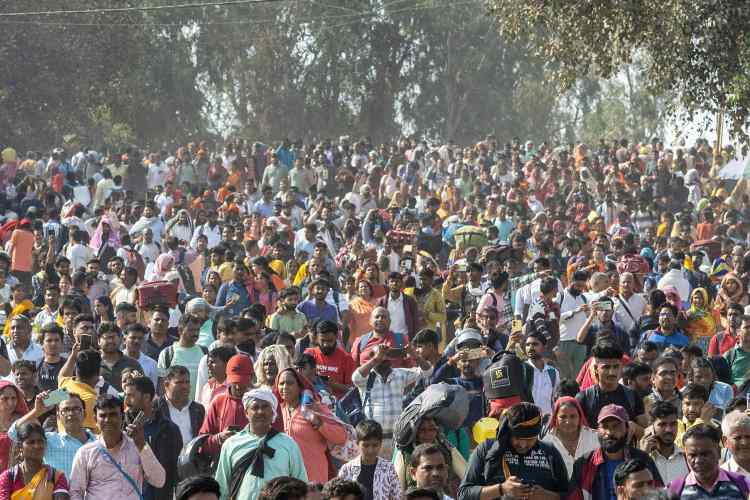India has just crossed a major milestone. With its population touching 1.46 billion in April 2025, the country has overtaken China as the most populous country, even as its fertility rate has slipped to 1.9 births per woman—below the replacement rate of 2.1. The milestone has triggered predictable hand-wringing about “too many mouths”, but the real story is subtler: a window of demographic dividend has narrowed further.
Roughly 68% Indians are now between 15 and 64 years of age. That confers a one-off demographic dividend, yet it paysonly when the principal is productively invested. India probably has three decades at most to align education, skilling and job creation with the youthful profile of its population. The Union Budget has begun to move the pieces—larger outlays for schools and vocational training, a multi-million-strong internship programme and continuing investments in skills missions. Private industry is slowly matching pace; energy companies, for example, are partnering with training institutes to seed green-economy jobs. But scale remains the enemy; barely one in three Indians aged 18-25 is enrolled in any form of tertiary or vocational learning.
READ | Coal’s last stand: Solar energy to power India’s future
The federal fault-lines
Aggregate fertility hides a dramatic north-south divide. Bihar’s fertility still hovers around 3.0 births per woman and Uttar Pradesh’s around 2.35, while Kerala, Tamil Nadu and Delhi have slipped to about 1.5. Uttar Pradesh alone will add more people this decade than the entire south combined. These imbalances will feed migration—internal and cross-border—unless two things happen quickly: labour-intensive industry moves north, and social investments travel south. Otherwise, India risks a politics of demographic grievance that could dwarf today’s boutique identity wars.
The latest State of World Population report highlights a stubborn fact: almost one-third of adult Indian women still face either unintended pregnancies or unmet desire for more children. Financial stress, insecure jobs, patchy childcare and partner pressure keep reproductive choice a mirage. Globally, policymakers worry about too few babies; for millions of Indian women, the worry is too little agency. Autonomy cannot be treated as a footnote to contraception. Unless gender gaps in wages, safe public spaces and decision-making power close decisively, India will squander both demographic dividend and demographic justice.
Ageing and shrinking, simultaneously
While Uttar Pradesh vies with Nigeria for baby booms, Kerala is already bracing for geriatric wards. The share of Indians over 60 will double—from 10% today to 20% by the early 2040s. Without mandatory savings, portable social pensions and a serious push into community nursing, states on the wrong side of the fertility divide will find long-term care costs crowding out schools and roads. Healthy ageing is not tomorrow’s problem; it is today’s capital budget.
For decades it was a rite of passage: the village youth boarding a train to Mumbai or Bengaluru. Yet recent household-consumption data suggest internal migration has slowed noticeably since 2011, helped by better rural jobs and welfare schemes. Rural consumption is now growing faster than urban, narrowing a yawning gap in just a dozen years. This is good news for social cohesion but bad news for factories that rely on mobile labour. The new reality underscores an old lesson: jobs must go to people, not the other way round.
Policy priorities for a grey-yet-young nation
Skill at scale, not in silos: India needs German-style dual apprenticeships embedded in industry clusters and funded by results, not inputs.
Childcare as growth infrastructure: When finances and childcare keep families smaller than desired, crèches are as critical as highways. Tax incentives for on-site childcare and a stronger anganwadi network would help.
Healthy ageing: States with fertility below 1.6 must front-load investments in geriatric medicine, reverse mortgages and elder-care cooperatives, learning from Japan before that experience becomes unaffordable to copy.
Better data, finer granularity: Fertility, migration and mortality should be tracked district-wise and released in machine-readable formats so that policy can be tailored, not templated.
Gender at the core: Every reform that enlarges women’s bargaining power—from safe transport to property rights—is a demographic reform in disguise. The cost of ignoring this lesson will be measured in lost GDP.
Demography, as the cliché goes, is destiny—but only for countries that refuse to write their own. India is lucky: it still enjoys a rising labour force and a global economy eager for an alternative manufacturing base. It is also warned: sub-replacement fertility, regional divergence and impending ageing are no longer distant abstractions. The next decade will decide whether 1.46 billion people become an engine of prosperity or a statistic in missed opportunity.
India’s true challenge is not population size but population utilisation. Utilising people means educating, skilling, freeing and caring for them—across gender, geography and generation. Get that right, and the dividend will compound long after the headcount stops growing. Get it wrong, and the moment will pass, leaving the world’s most populous nation as its most poignant could-have-been.

